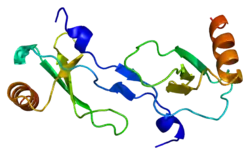CCL2
CCL2 (englisch CC-chemokine ligand 2 ‚CC-Chemokinligand 2‘) ist ein Zytokin aus der Familie der CC-Chemokine. Synonyme für das CCL2 sind monocyte chemotactic protein 1 (MCP1) und small inducible cytokine A2.
| CCL2 | ||
|---|---|---|
 | ||
| nach PDB 1DOK | ||
| Andere Namen |
| |
|
Vorhandene Strukturdaten: 1DOK, 1DOL, 1DOM, 1DON, 1MCA, 1ML0 | ||
| Eigenschaften des menschlichen Proteins | ||
| Masse/Länge Primärstruktur | 99 Aminosäuren, 11025 Da | |
| Bezeichner | ||
| Externe IDs | ||
| Orthologe | ||
| Mensch | Hausmaus | |
| Entrez | 6347 | 20293 |
| UniProt | P13500 | Q62401 |
| PubMed-Suche | 6347 | 20293 |
Eigenschaften
CCL2 wird an Orten einer Entzündung von Monozyten, T-Gedächtniszellen und dendritische Zellen gebildet, sezerniert, an Proteoglykane von Endothelzellen gebunden, durch die Matrix-Metalloprotease 12 (MMP-12) proteolytisch aktiviert und bindet dann diese Zelltypen dort.[1][2][3][4] CCL2 wird auch von Neuronen, Astrozyten und Mikroglia gebildet. Die Genexpression des CCL2 ist vornehmlich im Cortex cerebralis, im Globus pallidus, im Hippocampus, in den paraventrikulären und supraoptischen hypothalamischen Nuclei, in der Substantia nigra, im Nucleus motorius nervi facialis, in den trigeminalen motorischen und spinalen Nuclei, im gigantozellulären retikulären Nucleus und in den Purkinje-Zellen des Cerebellums.[5]
CCL2 wird von den Rezeptoren CCR2 und CCR4 gebunden.[6] Nach Stimulation von Zellen mit CCL2 wird die Genexpression von MCPIP1 induziert.
Einzelnachweise
- Carr MW, Roth SJ, Luther E, Rose SS, Springer TA: Monocyte chemoattractant protein 1 acts as a T-lymphocyte chemoattractant. In: Proceedings of the National Academy of Sciences. 91, Nr. 9, April 1994, S. 3652–6. doi:10.1073/pnas.91.9.3652. PMID 8170963. PMC 43639 (freier Volltext).
- Xu LL, Warren MK, Rose WL, Gong W, Wang JM: Human recombinant monocyte chemotactic protein and other C-C chemokines bind and induce directional migration of dendritic cells in vitro. In: Journal of Leukocyte Biology. 60, Nr. 3, September 1996, S. 365–71. PMID 8830793.
- Yoshimura T, Yuhki N, Moore SK, Appella E, Lerman MI, Leonard EJ: Human monocyte chemoattractant protein-1 (MCP-1). Full-length cDNA cloning, expression in mitogen-stimulated blood mononuclear leukocytes, and sequence similarity to mouse competence gene JE. In: FEBS Letters. 244, Nr. 2, Februar 1989, S. 487–93. doi:10.1016/0014-5793(89)80590-3. PMID 2465924.
- Furutani Y, Nomura H, Notake M, Oyamada Y, Fukui T, Yamada M, Larsen CG, Oppenheim JJ, Matsushima K: Cloning and sequencing of the cDNA for human monocyte chemotactic and activating factor (MCAF). In: Biochemical and Biophysical Research Communications. 159, Nr. 1, Februar 1989, S. 249–55. doi:10.1016/0006-291X(89)92430-3. PMID 2923622.
- Banisadr G, Gosselin RD, Mechighel P, Kitabgi P, Rostène W, Parsadaniantz SM: Highly regionalized neuronal expression of monocyte chemoattractant protein-1 (MCP-1/CCL2) in rat brain: evidence for its colocalization with neurotransmitters and neuropeptides. In: The Journal of Comparative Neurology. 489, Nr. 3, August 2005, S. 275–92. doi:10.1002/cne.20598. PMID 16025454.
- Craig MJ, Loberg RD: CCL2 (Monocyte Chemoattractant Protein-1) in cancer bone metastases. In: Cancer Metastasis Reviews. 25, Nr. 4, Dezember 2006, S. 611–9. doi:10.1007/s10555-006-9027-x. PMID 17160712.